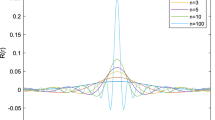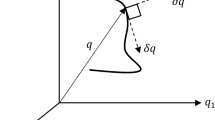Abstract
The three-body problem of quantum mechanics has been treated in appropriate co-ordinates. These are, besides those of the center-of-mass, the distances between the three particles and three Eulerian angles, fixing in space the position of the triangle formed by the particles. The Hamiltonian can be simplified by introducing the usual angular momentum operators of a gyrating rigid body. The solution of the wave equation has been discussed. Factorization into an angular part and a part depending on the particle distances only leads to certain linear combinations of such products. The angular parts have the well-known form of the representation coefficientsD L MK of the three-dimensional rotational group. The parts depending on the distances may be derived from a system of differential equations coupling, in two separate sets, either even or odd values ofK for each given value ofL.
Similar content being viewed by others
Author information
Authors and Affiliations
Rights and permissions
About this article
Cite this article
Diehl, H., Flügge, S., Schröder, U. et al. Zum quantenmechanischen Dreikörperproblem. Z. Physik 162, 1–14 (1961). https://doi.org/10.1007/BF01342461
Received:
Issue Date:
DOI: https://doi.org/10.1007/BF01342461




